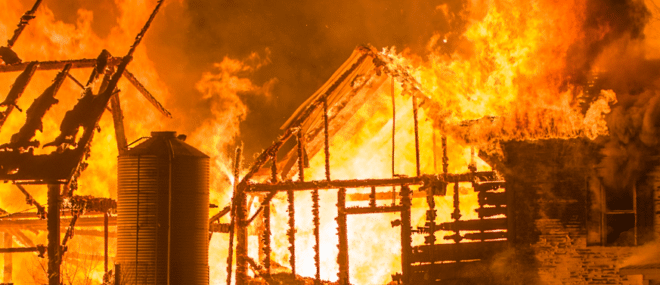On construction sites, temporary heaters can be used for heating tasks like ground thawing, concrete curing, or general drying purposes. They’re handy to have — especially through the winter — but can quickly turn into hazards: improperly installed temporary heaters can lead to major fire losses on construction projects. Temporary heater safety should be a top concern among construction and contracting risks.
The most common reason for fires resulting from temporary heating is a lack of proper clearance when the unit is installed. The “salamander” or “radiant” types of temporary heaters are direct-fired devices, typically fueled by propane, diesel, or natural gas. These un-vented and self-contained heaters are the ones you’ll find most often on worksites, but since they give off such intense heat, they typically require eight feet of clearance.
Guidelines for using temporary heaters
Proper clearance is a good first step, but it’s not the only point to consider when using a temporary heater. Here are some other things to keep in mind:
- Only use units that are officially “listed” or “approved” by a recognized testing organization, such as UL/ULC or CSA.
- Temporary heaters should be used for their intended purpose only, and installed and operated according to the manufacturer’s instructions.
- Check with your insurance company to ensure the type of heater you’re planning to use isn’t prohibited under your policy coverage.
- Establish a written operating procedure based on the manufacturer’s instructions to ensure safe installation and operation.
- Each heater has a data plate indicating the necessary clearances to combustibles, ventilation requirements, fuel type, etc. Adhere to those specifications!
You can also consider other types of temporary and portable heaters that may be safer to operate, like indirect-fired heaters, which are located outside the building. They require electricity to run and may not be as efficient as your salamander heaters, but they can be a good choice if you’re particularly concerned about ventilation and fire safety.
Portable heaters call for portable fire extinguishers
Where there’s smoke there’s fire, and where there’s fire there should be tools to keep it under control! Since temporary heaters carry a fire risk, you should have multi-purpose fire extinguishers close at hand on your construction site.
Fire extinguishers aren’t worth much if you don’t know how to use them properly. Remember the PASS acronym:
- Pull the pin
- Aim the nozzle at the base of the fire
- Squeeze the trigger
- Sweep the extinguisher from side to side
When it comes to risk, it’s not only site workers that you need to worry about, you’re also responsible for the safety of visitors to your construction site. It’s important that you not only keep hazards to a minimum, but also consider that visitors may be less aware of common risks or obstacles on a construction site. Preparing for potential incidents with relevant tools and processes is always a good idea.
Alternative solutions to temporary heaters
In some cases, it can be better to avoid using temporary heaters altogether. Here are some less risky ways to get the heat you need in order to keep working:
- Place a heater outside and away from the building. For hot air units, ductwork will be required to bring the heat into the building.
- Heating units that pipe hot water into a building and distribute the heat through various methods are safer alternatives to open-flame heaters. The heater should be in a safe location outside the building.
- If possible, rely on the building’s permanent heat source.
By implementing these safety tips for temporary heaters, you can rest easy knowing you’ve done what you can to protect your business. To learn more about how a tailored insurance policy can help protect you, your employees, and your bottom line, visit our Construction & Contractors Insurance page today.




